Supervised Machine Learning Algorithms to Discriminate Two Similar Marble Varieties, a Case Study
Abstract
1. Introduction
2. Materials and Methods
2.1. Archaeological Samples
2.1.1. The City Walls of Gerunda (Girona)
2.1.2. The Cloister of Saint Saviour’s Monastery (Breda)
2.1.3. The Inner Bailey of Montsoriu Castle
2.2. Quarry Samples
2.2.1. Gualba Marbles
2.2.2. Ceret Marbles
2.3. Methods
2.3.1. Experimental Methods
2.3.2. Statistical Methods
3. Results and Discussion
3.1. Petrography
3.1.1. Quarry Marbles
3.1.2. Archaeological Marbles
3.2. Cathodoluminescence
3.3. Stable Isotopes
3.3.1. Quarry Marbles
3.3.2. Archaeological Marbles
3.4. Energy Dispersive X-ray Fluorescence (EDXRF) and Unsupervised Multivariate Data Analysis (MDA)
3.5. Supervised Machine Learning Classification Models
3.5.1. Model Train and Test
3.5.2. Class Prediction
4. Conclusions
Supplementary Materials
Author Contributions
Funding
Data Availability Statement
Acknowledgments
Conflicts of Interest
References
- Ricca, M.; Paladini, G.; Rovella, N.; Ruffolo, S.A.; Randazzo, L.; Crupi, V.; Fazio, B.; Majolino, D.; Venuti, V.; Galli, G.; et al. Archaeometric Characterisation of Decorated Pottery from the Archaeological Site of Villa Dei Quintili (Rome, Italy): Preliminary Study. Geosciences 2019, 9, 172. [Google Scholar] [CrossRef]
- Herz, N. Provenance Determination of Neolithic to Classical Mediterranean Marbles Isotopes. Archaeometry 1992, 34, 185–194. [Google Scholar] [CrossRef]
- Brilli, M.; Savin, M.-C. Provenance Study of the White Marbles of the “Baths of Elagabalus” at the Palatine Hill in Rome. Archaeol. Anthropol. Sci. 2019, 11, 5539–5551. [Google Scholar] [CrossRef]
- Wielgosz-Rondolino, D.; Antonelli, F.; Bojanowski, M.J.; Gładki, M.; Göncüoğlu, M.C.; Lazzarini, L. Improved Methodology for Identification of Göktepe White Marble and the Understanding of Its Use: A Comparison with Carrara Marble. J. Archaeol. Sci. 2020, 113, 105059. [Google Scholar] [CrossRef]
- Brilli, M.; Cavazzini, G.; Turi, B. New Data of 87Sr/86Sr Ratio in Classical Marble: An Initial Database for Marble Provenance Determination. J. Archaeol. Sci. 2005, 32, 1543–1551. [Google Scholar] [CrossRef]
- Attanasio, D.; Platania, R.; Rocchi, P. White Marbles in Roman Architecture: Electron Paramagnetic Resonance Identification and Bootstrap Assessment of the Results. J. Archaeol. Sci. 2005, 32, 311–319. [Google Scholar] [CrossRef]
- Gutiérrez Garcia-M, A.; Savin, M.C.; Cantin, N.; Boudoumi, S.; Lapuente, P.; Chapoulie, R.; Pianet, I. NMR as a New Tool for Cultural Heritage Application: The Provenance of Ancient White Marbles. Archaeometry 2019, 61, 795–808. [Google Scholar] [CrossRef]
- Zöldföldi, J.; Hegedüs, P.; Székely, B. Interdisciplinary Data Base of Marble for Archaeometric, Art Historian and Restoration Use. In Ancient Mining in Turkey and the Eastern Mediterranean; Yalcin, Ü., Özbal, H., Pasamehmetoglu, G., Eds.; Atilim University: Ankara, Turkey, 2008; pp. 225–251. [Google Scholar]
- Antonelli, F.; Nestola, F. An Innovative Approach for Provenancing Ancient White Marbles: The Contribution of x-Ray Diffraction to Disentangling the Origins of Göktepe and Carrara Marbles. Sci. Rep. 2021, 11, 22312. [Google Scholar] [CrossRef]
- Lepsius, G.R. Griechische Marmorstudien; Verlag der Königlichen Akademie der Wissenschaften: Berlin, Germany, 1890. [Google Scholar]
- Poretti, G.; Brilli, M.; De Vito, C.; Conte, A.M.; Borghi, A.; Günther, D.; Zanetti, A. New Considerations on Trace Elements for Quarry Provenance Investigation of Ancient White Marbles. J. Cult. Herit. 2017, 28, 16–26. [Google Scholar] [CrossRef]
- Prochaska, W. The Challenge of a Successful Discrimination of Ancient Marbles (Part II): A Databank for the Alpine Marbles. J. Archaeol. Sci. Rep. 2021, 38, 102958. [Google Scholar] [CrossRef]
- Prochaska, W.; Attanasio, D. The Challenge of a Successful Discrimination of Ancient Marbles (Part III): A Databank for Aphrodisias, Carrara, Dokimeion, Göktepe, Hymettos, Parian Lychnites and Pentelikon. J. Archaeol. Sci. Rep. 2022, 45, 103582. [Google Scholar] [CrossRef]
- Vasiliki, A.; Sabine, L.; Walter, P. Meter Reliefs from Ephesos and the Obizzi Collection (KHM Wien). Archaeometric Considerations on the Production and Trade of Small-Format Marble Objects in the Greek World. J. Archaeol. Sci. Rep. 2023, 47, 103742. [Google Scholar] [CrossRef]
- Vettor, T.; Sautter, V.; Pont, S.; Harivel, C.; Jolivet, L.; Moretti, I.; Moretti, J.C. Delos Archaeological Marbles: A Preliminary Geochemistry-Based Quarry Provenance Study. Archaeometry 2021, 63, 907–922. [Google Scholar] [CrossRef]
- Efenberger-Szmechtyk, M.; Nowak, A.; Kregiel, D. Implementation of Chemometrics in Quality Evaluation of Food and Beverages. Crit. Rev. Food Sci. Nutr. 2018, 58, 1747–1766. [Google Scholar] [CrossRef]
- Baxter, M.J. Standardization and Transformation in Principal Component Analysis, with Applications to Archaeometry. J. R. Stat. Soc. Ser. C Appl. Stat. 1995, 44, 513–527. [Google Scholar] [CrossRef]
- McKeague, P.; van’t Veer, R.; Huvila, I.; Moreau, A.; Verhagen, P.; Bernard, L.; Cooper, A.; Green, C.; van Manen, N. Mapping Our Heritage: Towards a Sustainable Future for Digital Spatial Information and Technologies in European Archaeological Heritage Management. J. Comput. Appl. Archaeol. 2019, 2, 89–104. [Google Scholar] [CrossRef]
- Fiorucci, M.; Khoroshiltseva, M.; Pontil, M.; Traviglia, A.; Del Bue, A.; James, S. Machine Learning for Cultural Heritage: A Survey. Pattern Recognit. Lett. 2020, 133, 102–108. [Google Scholar] [CrossRef]
- Oonk, S.; Spijker, J. A Supervised Machine-Learning Approach towards Geochemical Predictive Modelling in Archaeology. J. Archaeol. Sci. 2015, 59, 80–88. [Google Scholar] [CrossRef]
- Lopez-Garcia, P.A.; Argote, D.L.; Thrun, M.C. Projection-Based Classification of Chemical Groups for Provenance Analysis of Archaeological Materials. IEEE Access. 2020, 8, 152439–152451. [Google Scholar] [CrossRef]
- Barone, G.; Mazzoleni, P.; Spagnolo, G.V.; Raneri, S. Artificial Neural Network for the Provenance Study of Archaeological Ceramics Using Clay Sediment Database. J. Cult. Herit. 2019, 38, 147–157. [Google Scholar] [CrossRef]
- Ma, Q.; Yan, A.; Hu, Z.; Li, Z.; Fan, B. Principal Component Analysis and Artificial Neural Networks Applied to the Classification of Chinese Pottery of Neolithic Age. Anal. Chim. Acta 2000, 406, 247–256. [Google Scholar] [CrossRef]
- Anglisano, A.; Casas, L.; Anglisano, M.; Queralt, I. Application of Supervised Machine-Learning Methods for Attesting Provenance in Catalan Traditional Pottery Industry. Minerals 2020, 10, 8. [Google Scholar] [CrossRef]
- Anglisano, A.; Casas, L.; Queralt, I.; Di Febo, R. Supervised Machine Learning Algorithms to Predict Provenance of Archaeological Pottery Fragments. Sustainability 2022, 14, 11214. [Google Scholar] [CrossRef]
- Nolla i Brufau, J.M.; Amich i Raurich, N.M.; Castanyer i Masoliver, P. El Baix Imperi. La Consolidació de La Ciutat. In Història de Girona; Costa, L., Maroto, J., Eds.; CCG Edicions: Girona, Spain, 2006; pp. 93–100. [Google Scholar]
- Nolla, J.M. Girona Romana. de la Fundació a la Fi del Món Antic; Ajuntament de Girona. Diputació de Girona: Girona, Spain, 1987. [Google Scholar]
- Nolla, J.M.; Sagrera, J. Noves Exploracions Arqueològiques a La Caserna d’Alemanys (Girona). Campanya d’excavacions de 1988. Cypsela 1991, IX, 177–195. [Google Scholar]
- Oliver Vert, J. The Commemorative Roman Arch-Gate of Gerunda (Girona). Arqueol. De La Arquit. 2019, 16, e082. [Google Scholar]
- Oliver, J.; Gutiérrez, A. Torre Del Telègraf Òptic o Del Llamp–Recollida de Mostres per Anàlisi Arqueomètrica Del Material Lapidi (Girona, Gironès). In Proceedings of the Quinzenes Jornades d’Arqueologia de les Comarques de Girona; Burch, J., Buxó, R., Frigola, J., Fuertes, M., Manzano, S., Mataró, M., Eds.; Generalitat de Catalunya, Museu d’Arqueologia de Catalunya, Universitat de Girona, Documenta Universitaria: Castelló d’Empúries, Spain, 2020; pp. 255–258. [Google Scholar]
- Pou, J.; Frigola, J.; Òdena, J.L. Intervenció Arqueològica al Claustre Del Monestir de Sant Salvador (Breda, La Selva). In Proceedings of the Quinzenes Jornades d’Arqueologia de les Comarques de Girona; Burch, J., Buxó, R., Frigola, J., Fuertes, M., Manzano, S., Mataró, M., Eds.; Generalitat de Catalunya, Museu d’Arqueologia de Catalunya, Universitat de Girona, Documenta Universitaria: Castelló d’Empúries, Spain, 2020; pp. 451–455. [Google Scholar]
- Tura i Masnou, J.; Pujadas i Mitjà, S.; Mateu i Gasquet, J.; Llorens i Rams, J.M.; Font i Valentí, G. Excavacions Arqueològiques al Castell de Montsoriu. Campanyes 2016–2017 (Arbúcies-Sant Feliu de Buixalleu, La Selva). In Proceedings of the Catorzenes Jornades d’Arqueologia de les Comarques de Girona, Caldes de Malavella, 2018; Buxó, R., Manzano, S., Mataró, M., Nolla, J.M., Eds.; Generalitat de Catalunya, Museu d’Arqueologia de Catalunya, Universitat de Girona, Ajuntament de Caldes de Malavella: Caldes de Malavella, Spain, 2018; pp. 485–495. [Google Scholar]
- Font, G.; Llorens, J.M.; Mateu, J.; Pujadas, S.; Rueda, J.M.; Tura, J. El Castell de Montsoriu. Configuració Arquitectònica d’un Gran Palau Gòtic, a Partir de Les Tasques Arqueològiques Desenvolupades Entre Els Anys 2001 i 2004. In Proceedings of the VI Trobada d’Estudiosos del Montseny; Hernández, J., Santiago, S., Melero, J., Eds.; Diputació de Barcelona: Barcelona, Spain, 2005; pp. 185–189. [Google Scholar]
- Huerta, J. El Paleozoico Inferior Del Montseny. Acta Geologica Hispanica 1990, 25, 105–111. [Google Scholar]
- Liesa, M.; Carreras, J. On the Structure and Metamorphism of the Roc de Frausa Massif (Eastern Pyrenees). Geodin. Acta 1989, 3, 149–161. [Google Scholar] [CrossRef]
- Aguilar, C.; Liesa, M.; Štípská, P.; Schulmann, K.; Muñoz, J.A.; Casas, J.M. P–T–t–d Evolution of Orogenic Middle Crust of the Roc de Frausa Massif (Eastern Pyrenees): A Result of Horizontal Crustal Flow and Carboniferous Doming? J. Metamorph. Geol. 2015, 33, 273–294. [Google Scholar] [CrossRef]
- Pagniez, L. Le Marbre de Céret: Un Matériau Complexe et Méconnu de La Production Artistique Roussillonnaise (XIe-XVe Siècle). Les Cahiers De Saint-Michel-De-Cuxa 2002, 33, 159–171. [Google Scholar]
- Mallet, G. De l’usage Des Marbres En Roussillon Entre Le XIe et Le XIVe Siècle: La Sculpture Monumentale. Parimoines du Sud. 2016, 4, 29–51. [Google Scholar] [CrossRef]
- Álvarez, A.; Rodà, I.; Mayer, M. Mármoles y Calizas de Los Pirineos Centrales y Su Utilización En Época Romana. In Proceedings of the Les Ressources Naturelles des Pyrénées. Leur Exploitation durant l’Antiquité (Toulouse 1999); Sablayrolles, R., Ed.; Musée archéologique départemental: Saint-Bertrand-de-Comminges, France, 2001; pp. 47–67. [Google Scholar]
- Mallet, G. De Catalogne En Languedoc Méditerranéen Au Moyen Âge (IVe-XIIe Siècles): Questions Sur Les Remplois En Marbre Blanc à Travers Les Exemples Roussillonnais. Hortus Artium Medievalium 2011, 17, 77–84. [Google Scholar] [CrossRef]
- Ponsich, P. Les plus Anciennes Sculptures Médiévales Du Roussillon (Ve-XIe Siècle). Les cahiers de Saint-Michel-de-Cuxa 1980, 11, 293–331. [Google Scholar]
- Pagniez, L. La Production Artistique Roussillonnaise En Marbre de Céret (XIe-XVe Siècle); Mémoire de Maîtrise, Université Paul-Valéry: Montpellier, France, 1999. [Google Scholar]
- Gély, J.-P. Le Marbre de Céret (Pyrénées-Orientales): Neuf Siècles d’extraction et d’emploi Dans La Décoration de l’art Roussillonnais. In Proceedings of the Carrières et Constructions en France et dans les Pays Limitrophes, III, Actes du 119e Congrès National des Sociétés Historiques et Scientifiques (Amiens, 1994); Lorenz, J., Ed.; Éditions du CTHS: Amiens, France, 1996; pp. 385–397. [Google Scholar]
- Blanc, P.; Gély, J.-P. L’analyse de La Provenance Des Marbres Blancs Par Cathodoluminescence et Son Application Au Marbre de Céret. In Pierre et Archéologie; Lorenz, J., Miskovsky, J.-C., Eds.; Presses Universitaires de Perpignan: Perpignan, France, 2002; pp. 81–113. [Google Scholar]
- Giresse, P.; de Barrau, C.; Bromblet, P. Les Marbres et Les Calcaires de La Façade de l’abbatiale Romane de Saint-André-de-Sorède (Sud Du Roussillon). Sources, Emplois et Réemplois. In El coste de la construcción medieval: Materiales, recursos y sistemas constructivos para la petrificación del paisaje entre los siglos XI y XIII.; Maira Vidal, R., Rodríguez, A., Eds.; Instituto de Historia (CSIC)-Instituto Juan de Herrera: Madrid, Spain, 2021; pp. 187–205. [Google Scholar]
- Giresse, P.; Bromblet, P.; Barrau, C. de Le Marbre de Carrare Dans Les Oeuvres Romanes Du Roussillon Pendant Le Xie Siècle (Linteau de Saint-Genis-Desfontaines, Linteau et Table d’autel de Saint-André-Desorède). Analyses Texturales et Isotopiques. ArcheoSciences 2020, 44, 71–79. [Google Scholar] [CrossRef]
- Lapuente Mercadal, M.P.; Cuchí Oterino, J.A.; Royo Plumed, H.; Preite Martínez, M.; Blanc, P.; Garcés Manau, C. Study of Provenance of the Roman Sarcophagus Known Today as the Tomb of King Ramiro II of Aragon. In Proceedings of the Interdisciplinary Studies on Ancient Stone: Proceedings of the IX Association for the Study of Marbles and Other Stones in Antiquity (ASMOSIA) Conference (Tarragona 2009); Gutiérrez García-Moreno, A., Lapuente Mercadal, M.P., Rodà de Llanza, I., Eds.; Institut Català d’Arqueologia: Tarragona, Spain, 2012; pp. 419–425. [Google Scholar]
- Wickham, H.; Bryan, J. R Packages, 2nd ed.; O’Reilly Media Inc.: Sebastopol, CA, USA, 2023; ISBN 9781098134945. [Google Scholar]
- Burkhard, M. Calcite Twins, Their Geometry, Appearance and Significance as Stress-Strain Markers and Indicators of Tectonic Regime: A Review. J. Struct. Geol. 1993, 15, 351–368. [Google Scholar] [CrossRef]
- Valley, J.W. Stable Isotope Geochemistry of Metamorphic Rocks. Rev. Mineral. Geochem. 1986, 16, 445–489. [Google Scholar]
- Sharp, Z.D. Metamorphic Petrology. In Principles of Stable Isotope Geochemistry; Pearson/Prentice Hall: Upper Saddle River, NJ, USA, 2007; pp. 1–36. ISBN 0130091391. [Google Scholar]
- Dessandier, D.; Bromblet, P.; Leroux, L. Étude Des. Pierres de Monuments Emblématiques Du. Bâti Historique de Perpignan. (66); BRGM: Perpignan, France, 2011. [Google Scholar]
- Antonelli, F.; Lazzarini, L. An Updated Petrographic and Isotopic Reference Database for White Marbles Used in Antiquity. Rendiconti Lincei 2015, 26, 399–413. [Google Scholar] [CrossRef]
- Moreira, A.J.C.; Santos, M.Y. Concave Hull: A k-Nearest Neighbours Approach for the Computation of the Region Occupied by a Set of Points. In Proceedings of the International Conference on Computer Graphics Theory and Applications; SciTePress: Setúbal, Portugal, 2007. [Google Scholar]
- Carr, D.D.; Rooney, L.F. Limestone and Dolomite. In Industrial Minerals and Rocks; Lefond, S.Y., Ed.; American Institute of Mining, Metallurgical, and Petroleum Engineers, Inc.: New York, NY, USA, 1983; pp. 833–868. [Google Scholar]
- De Soto Cañamares, P. Anàlisi de La Xarxa de Comunicacions i Del Transport a La Catalunya Romana: Estudis de Distribució i Mobilitat. Doctoral Thesis, Institut Català d’Arqueologia Clàssica-Universitat Autònoma de Barcelona, Tarragona, Spain, 2010. [Google Scholar]
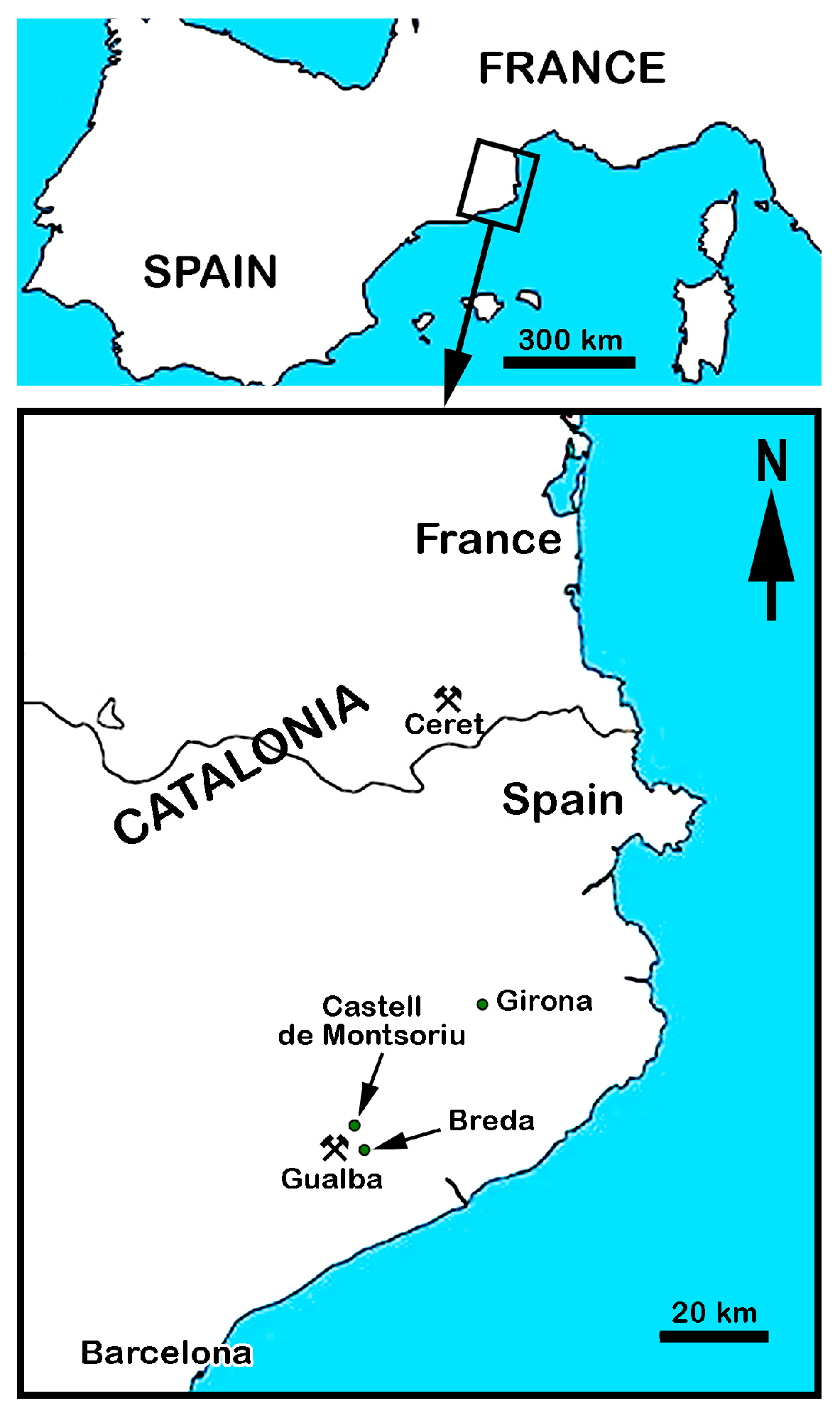
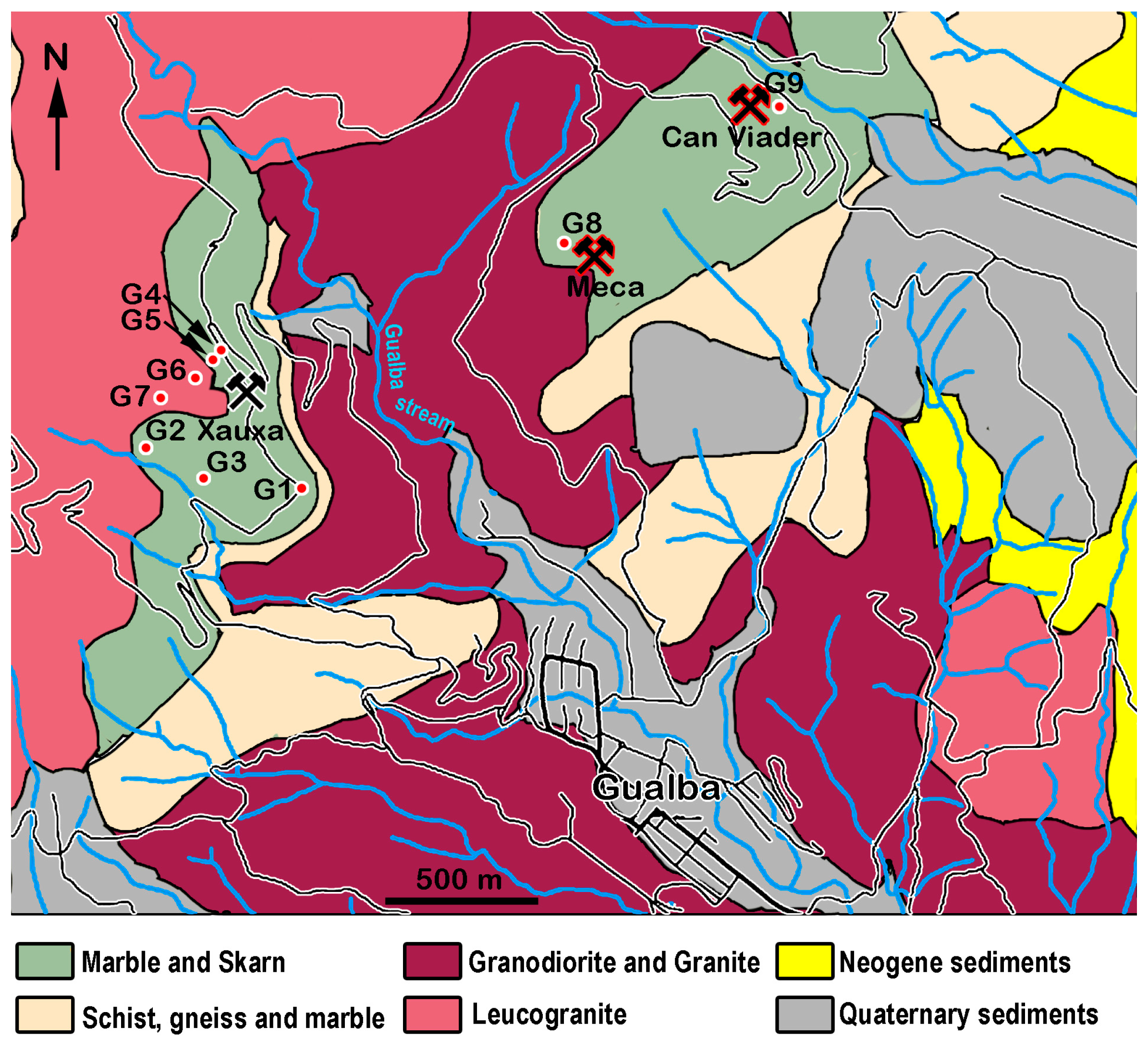
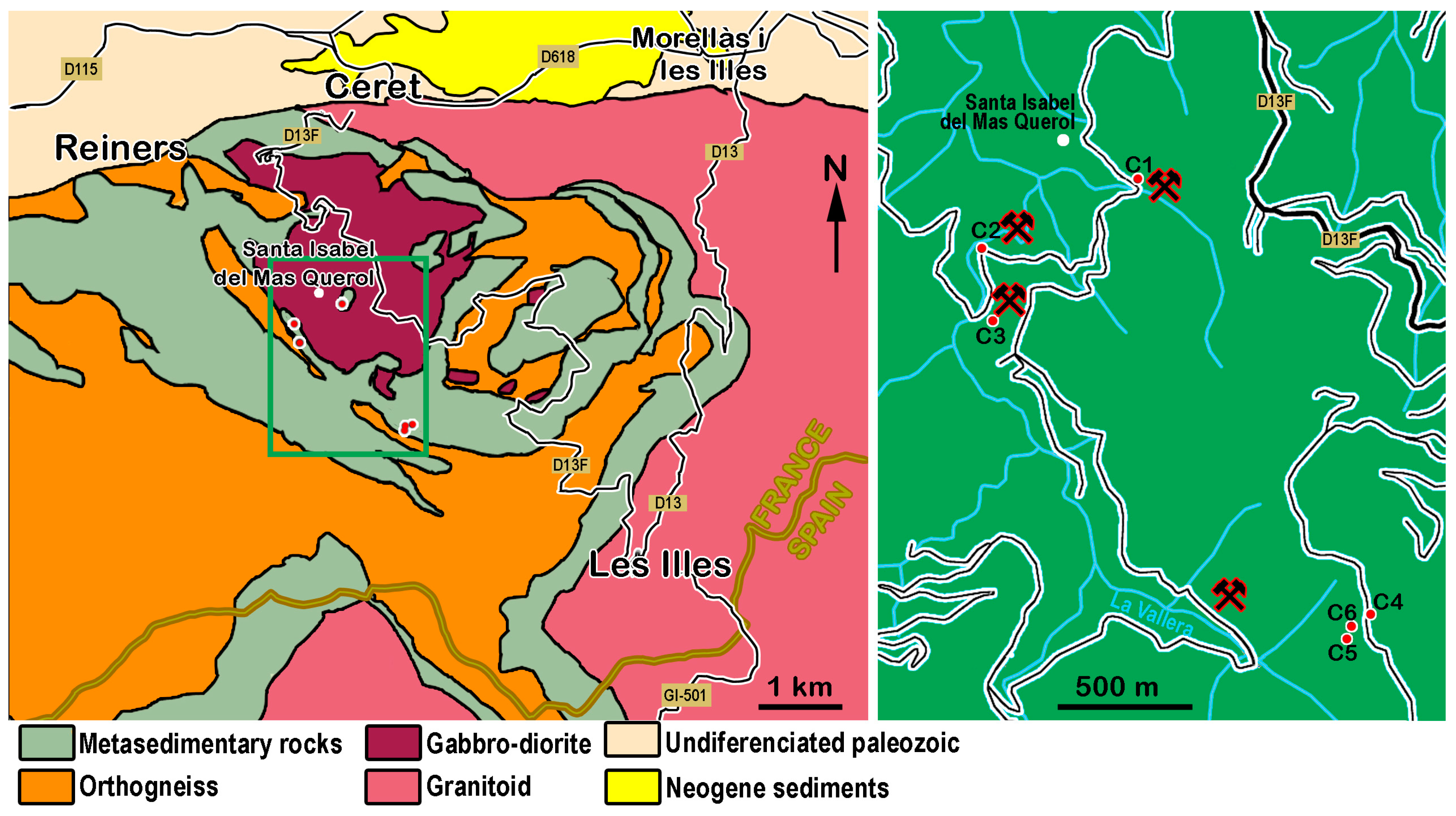
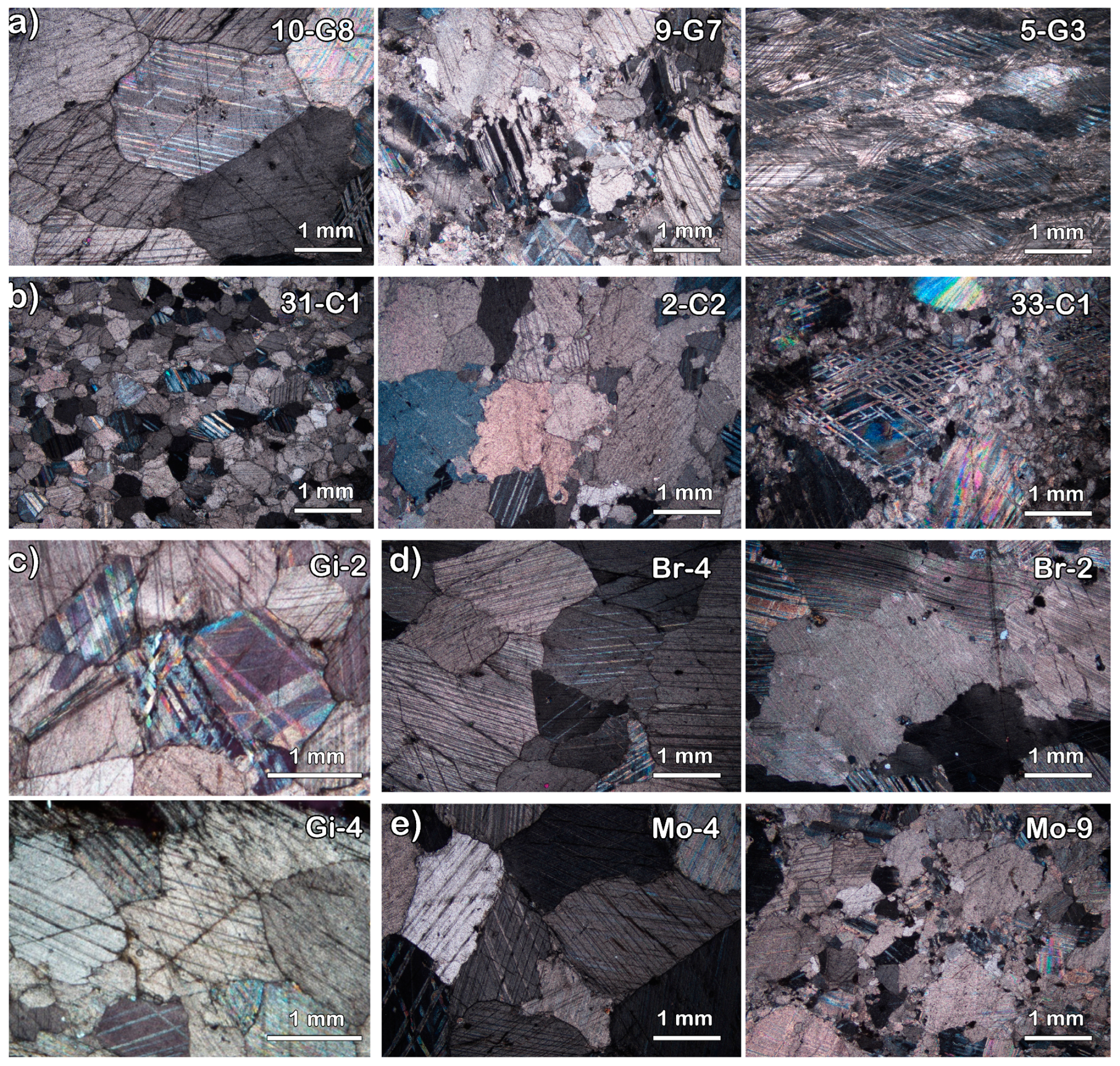
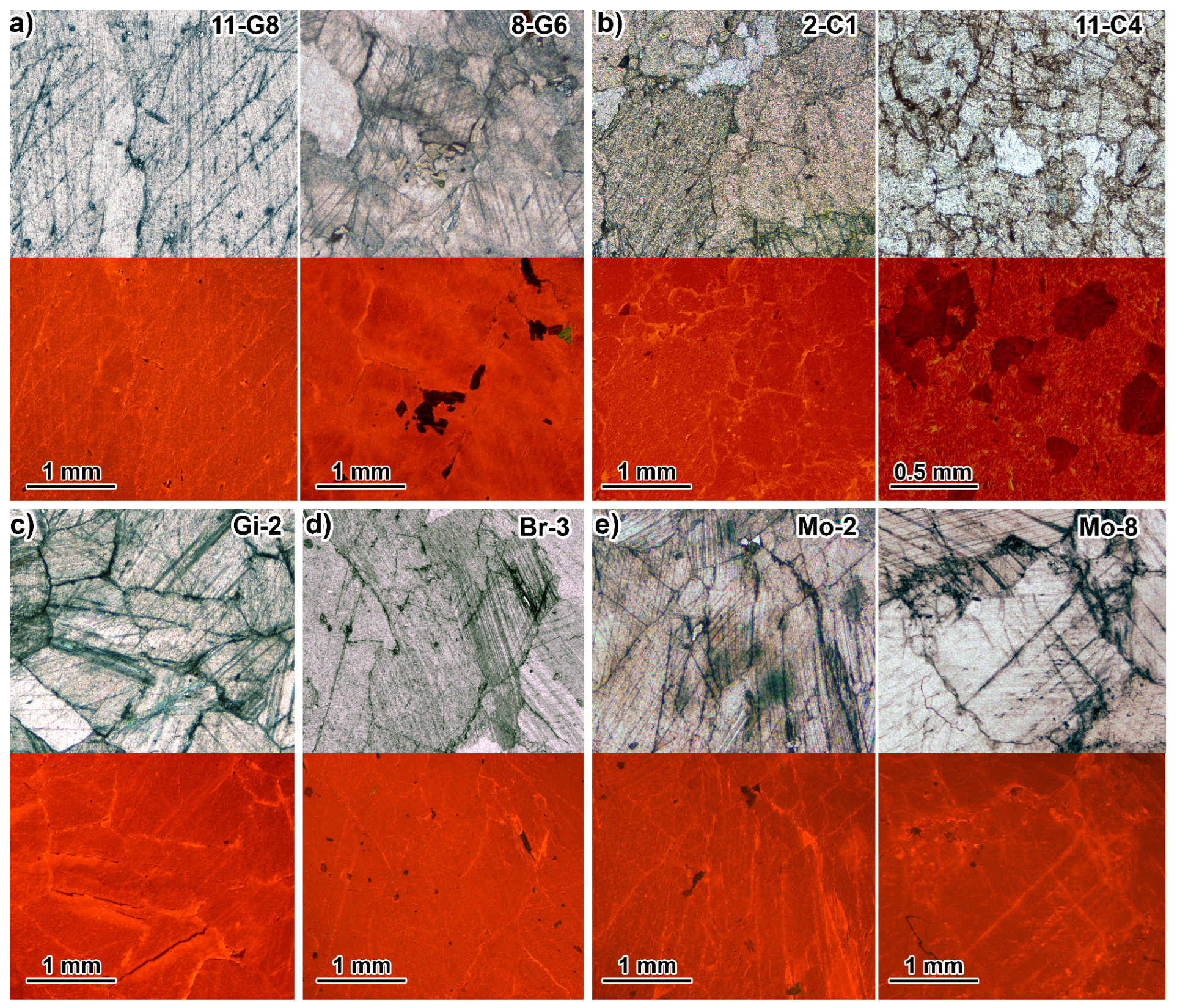


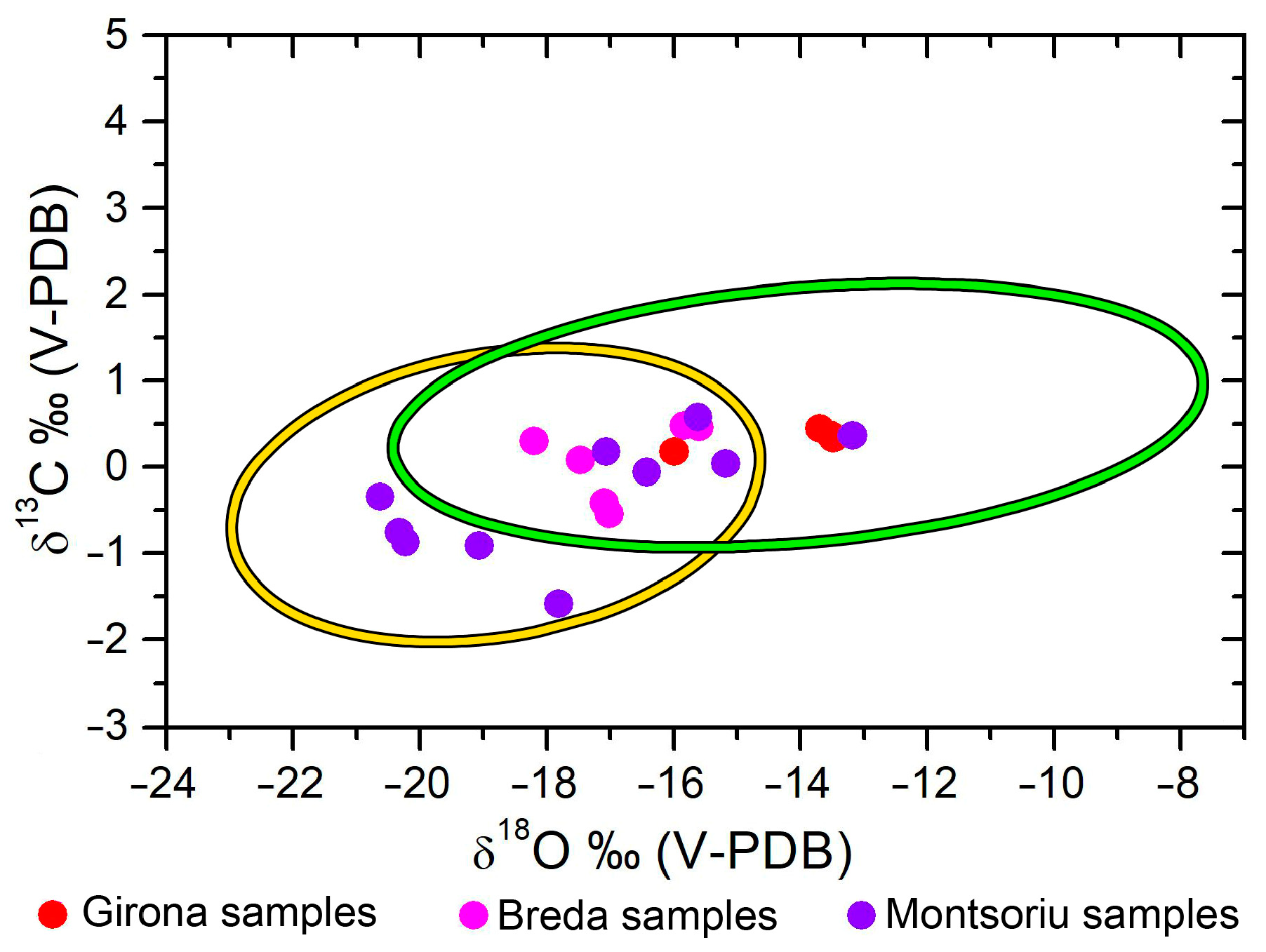
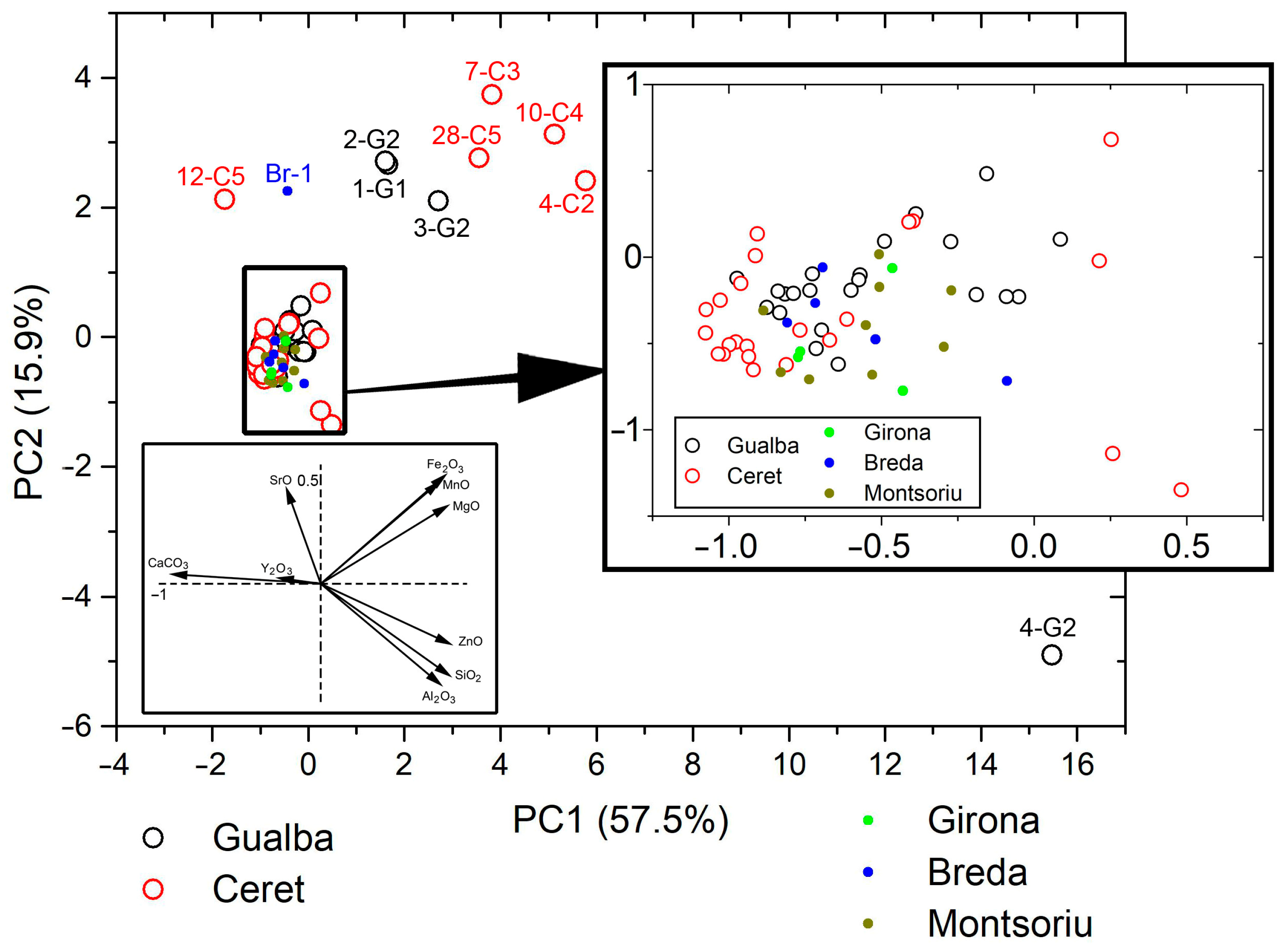
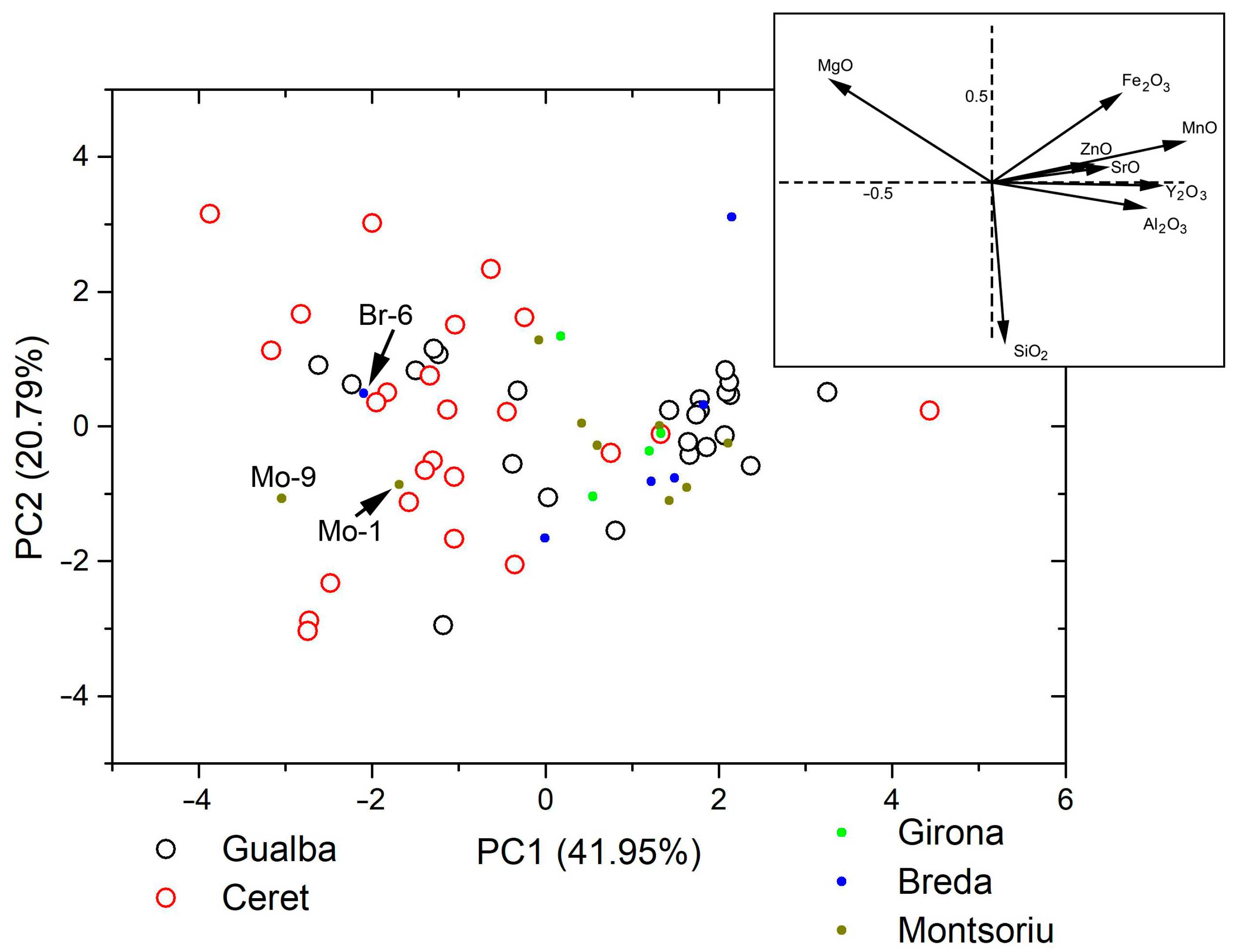


| CaCO3 (%) | MgO (%) | SiO2 (%) | Al2O3 (%) | Mn (ppm) | Fe (ppm) | Sr (ppm) | Zn (ppm) | Y (ppm) | |
|---|---|---|---|---|---|---|---|---|---|
| 1-G1 | 93.4 | 1.53 | 3.16 | 0.34 | 1365 | 4791 | 183 | 26 | 14 |
| 2-G2 | 93.4 | 1.57 | 3.13 | 0.30 | 1310 | 4966 | 186 | 25 | 14 |
| 3-G2 | 81.0 | 16.70 | 0.86 | 0.14 | 618 | 3987 | 92 | 30 | 2 |
| 4-G2 | 32.0 | 17.80 | 44.90 | 3.08 | 1492 | 6050 | 29 | 1719 | 1 |
| 5-G3 | 97.9 | 0.10 | 1.32 | 0.38 | 375 | 906 | 144 | 14 | 11 |
| 6-G4 | 99.0 | n.d. | 0.44 | 0.31 | 402 | 601 | 121 | 12 | 9 |
| 7-G5 | 95.5 | n.d. | 3.81 | 0.38 | 644 | 734 | 150 | 23 | 18 |
| 8-G6 | 95.7 | 1.45 | 1.86 | 0.54 | 473 | 1434 | 151 | 11 | 9 |
| 9-G7 | 97.6 | 0.59 | 1.02 | 0.38 | 400 | 1259 | 108 | 8 | 0 |
| 10-G8 | 98.8 | 0.02 | 0.64 | 0.35 | 339 | 598 | 110 | 17 | 9 |
| 11-G8 | 98.6 | n.d. | 0.75 | 0.31 | 448 | 801 | 118 | 21 | 9 |
| 12-G8 | 98.4 | n.d. | 0.79 | 0.35 | 564 | 1206 | 138 | 13 | 11 |
| 13-G9 | 99.2 | 0.04 | 0.38 | 0.24 | 277 | 395 | 101 | 9 | 2 |
| 14-G9 | 98.1 | 0.08 | 0.89 | 0.50 | 691 | 1140 | 173 | 14 | 10 |
| 15-G8 | 98.6 | 0.01 | 0.74 | 0.31 | 497 | 1000 | 130 | 10 | 9 |
| 16-G8 | 98.7 | 0.05 | 0.68 | 0.31 | 401 | 787 | 118 | 19 | 8 |
| 17-G5 | 98.7 | 0.02 | 0.70 | 0.29 | 418 | 608 | 129 | 7 | 9 |
| 18-G5 | 96.9 | 1.25 | 1.28 | 0.31 | 406 | 790 | 113 | 16 | 3 |
| 19-G5 | 99.0 | n.d. | 0.58 | 0.23 | 383 | 416 | 104 | 10 | 9 |
| 20-G9 | 98.6 | 0.15 | 0.69 | 0.37 | 233 | 430 | 116 | 5 | 3 |
| 21-G6 | 98.9 | 0.04 | 0.51 | 0.22 | 342 | 741 | 110 | 9 | 9 |
| 22-G6 | 99.0 | 0.07 | 0.49 | 0.22 | 347 | 706 | 112 | 9 | 10 |
| 23-G3 | 98.9 | 0.07 | 0.57 | 0.22 | 310 | 472 | 139 | 10 | 10 |
| 24-G6 | 99.2 | 0.03 | 0.38 | 0.16 | 328 | 591 | 113 | 6 | 4 |
| 25-G7 | 97.3 | 0.67 | 1.46 | 0.22 | 457 | 1039 | 96 | 108 | 4 |
| 26-G5 | 98.5 | n.d. | 0.96 | 0.31 | 287 | 465 | 139 | 15 | 10 |
| CaCO3 (%) | MgO (%) | SiO2 (%) | Al2O3 (%) | Mn (ppm) | Fe (ppm) | Sr (ppm) | Zn (ppm) | Y (ppm) | |
|---|---|---|---|---|---|---|---|---|---|
| 1-C1 | 98.9 | 0.37 | 0.46 | 0.20 | 148 | 138 | 109 | 4 | 2 |
| 2-C1 | 98.5 | 0.57 | 0.52 | 0.22 | 275 | 546 | 156 | 9 | 8 |
| 3-C2 | 98.5 | 0.48 | 0.66 | 0.23 | 186 | 455 | 95 | 4 | 5 |
| 4-C2 | 79.6 | 16.80 | 1.38 | 0.24 | 1350 | 5700 | 96 | 1012 | n.d. |
| 5-C2 | 99.0 | 0.36 | 0.33 | 0.18 | 166 | 271 | 151 | 24 | 4 |
| 6-C3 | 98.7 | 0.54 | 0.33 | 0.19 | 260 | 525 | 131 | 10 | 9 |
| 7-C3 | 81.6 | 16.00 | 0.46 | 0.22 | 1476 | 5141 | 134 | 23 | n.d. |
| 8-C3 | 98.9 | 0.28 | 0.46 | 0.22 | 138 | 256 | 130 | 6 | 3 |
| 9-C4 | 94.9 | 3.50 | 0.97 | 0.16 | 530 | 1350 | 151 | 45 | n.d. |
| 10-C4 | 74.9 | 16.20 | 6.63 | 0.34 | 1539 | 6050 | 83 | 47 | n.d. |
| 11-C4 | 99.0 | 0.21 | 0.51 | 0.19 | 144 | 106 | 132 | 10 | n.d. |
| 12-C5 | 99.3 | n.d. | 0.36 | 0.13 | 209 | 296 | 458 | 10 | 7 |
| 13-C6 | 98.6 | 0.05 | 1.01 | 0.24 | 185 | 281 | 126 | 11 | 8 |
| 14-C2 | 91.7 | 0.65 | 6.57 | 0.79 | 210 | 678 | 129 | 10 | 6 |
| 15-C6 | 98.3 | 0.21 | 1.13 | 0.27 | 158 | 272 | 126 | 10 | 9 |
| 16-C6 | 91.6 | 0.61 | 6.91 | 0.65 | 218 | 650 | 136 | 11 | 9 |
| 17-C1 | 99.2 | 0.19 | 0.37 | 0.16 | 147 | 198 | 112 | 7 | 3 |
| 18-C2 | 96.9 | 1.50 | 0.94 | 0.41 | 302 | 825 | 196 | 7 | 4 |
| 20-C5 | 97.3 | 0.57 | 1.43 | 0.49 | 281 | 514 | 156 | 11 | 11 |
| 22-C3 | 99.2 | 0.09 | 0.36 | 0.21 | 174 | 227 | 129 | 8 | 6 |
| 23-C5 | 98.9 | 0.19 | 0.66 | 0.19 | 124 | 127 | 129 | 10 | n.d. |
| 24-C6 | 97.0 | 0.36 | 2.28 | 0.24 | 211 | 346 | 135 | 3 | 4 |
| 25-C6 | 99.0 | 0.12 | 0.52 | 0.19 | 215 | 315 | 134 | 8 | 8 |
| 26-C6 | 97.9 | 0.38 | 1.19 | 0.27 | 296 | 483 | 188 | 10 | 10 |
| 27-C6 | 94.6 | 2.35 | 1.80 | 0.70 | 318 | 1112 | 196 | 8 | 4 |
| 28-C5 | 80.1 | 16.00 | 1.76 | 0.70 | 884 | 4546 | 218 | 24 | n.d. |
| 29-C2 | 97.8 | 1.20 | 0.47 | 0.20 | 500 | 1032 | 114 | 6 | 7 |
| 30-C2 | 98.6 | 0.43 | 0.60 | 0.18 | 275 | 462 | 100 | 6 | 4 |
| CaCO3 (%) | MgO (%) | SiO2 (%) | Al2O3 (%) | Mn (ppm) | Fe (ppm) | Sr (ppm) | Zn (ppm) | Y (ppm) | |
|---|---|---|---|---|---|---|---|---|---|
| Gi-1 | 98.7 | n.d. | 0.68 | 0.45 | 302 | 371 | 101 | 9 | 1 |
| Gi-2 | 99.3 | 0.01 | 0.39 | 0.18 | 266 | 378 | 87 | 7 | 2 |
| Gi-3 | 98.3 | 0.32 | 0.69 | 0.27 | 399 | 1262 | 107 | 11 | 8 |
| Gi-4 | 98.9 | 0.08 | 0.59 | 0.29 | 320 | 413 | 94 | 10 | 8 |
| Br-1 | 98.1 | 0.19 | 0.55 | 0.32 | 574 | 2630 | 341 | 11 | 11 |
| Br-2 | 98.3 | 0.00 | 1.14 | 0.35 | 357 | 532 | 111 | 11 | 5 |
| Br-3 | 98.7 | 0.02 | 0.71 | 0.34 | 321 | 511 | 120 | 10 | 11 |
| Br-4 | 98.7 | 0.05 | 0.68 | 0.28 | 398 | 920 | 123 | 14 | 11 |
| Br-5 | 98.6 | 0.03 | 0.83 | 0.35 | 367 | 588 | 128 | 12 | 10 |
| Br-6 | 97.1 | 0.85 | 1.14 | 0.59 | 227 | 874 | 121 | 11 | 1 |
| Mo-1 | 98.0 | 0.34 | 1.11 | 0.37 | 202 | 458 | 116 | 10 | 1 |
| Mo-2 | 98.5 | 0.07 | 0.73 | 0.42 | 298 | 724 | 129 | 9 | 6 |
| Mo-3 | 98.2 | 0.16 | 0.90 | 0.39 | 369 | 1007 | 129 | 12 | 9 |
| Mo-4 | 98.8 | 0.02 | 0.65 | 0.38 | 267 | 371 | 102 | 14 | 11 |
| Mo-5 | 98.8 | n.d. | 0.53 | 0.46 | 376 | 588 | 114 | 10 | n.d. |
| Mo-7 | 99.1 | n.d. | 0.50 | 0.25 | 291 | 507 | 121 | 7 | 8 |
| Mo-8 | 98.7 | n.d. | 0.75 | 0.43 | 266 | 416 | 105 | 18 | 10 |
| Mo-9 | 95.5 | 1.18 | 2.88 | 0.19 | 366 | 717 | 123 | 7 | 4 |
| Mo-10 | 98.1 | 0.49 | 0.74 | 0.32 | 461 | 1021 | 120 | 12 | 11 |
| Group 1 | Group 2 | |
|---|---|---|
| Gualba | 19 | 6 |
| Ceret | 4 | 20 |
| Girona | 4 | 0 |
| Breda | 4 | 2 |
| Montsoriu | 7 | 2 |
| Model | Quarry | Archaeological Site | ||
|---|---|---|---|---|
| Gerunda walls (Girona) | Breda’s monastery | Montsoriu Castle | ||
| GLM | Gualba | 0.75 ± 0.15 | 0.75 ± 0.23 | 0.66 ± 0.27 |
| Ceret | 0.25 ± 0.15 | 0.25 ± 0.23 | 0.34 ± 0.27 | |
| RF | Gualba | 0.71 ± 0.10 | 0.80 ± 0.21 | 0.69 ± 0.19 |
| Ceret | 0.29 ± 0.10 | 0.20 ± 0.21 | 0.31 ± 0.19 | |
| ANN | Gualba | 0.94 ± 0.06 | 0.95 ± 0.05 | 0.81 ± 0.31 |
| Ceret | 0.06 ± 0.06 | 0.05 ± 0.05 | 0.19 ± 0.31 | |
| kkNN | Gualba | 0.96 ± 0.12 | 0.91 ± 0.26 | 0.89 ± 0.29 |
| Ceret | 0.04 ± 0.12 | 0.09 ± 0.26 | 0.11 ± 0.29 | |
| LDA | Gualba | 0.91 ± 0.12 | 0.84 ± 0.30 | 0.79 ± 0.32 |
| Ceret | 0.09 ± 0.12 | 0.16 ± 0.30 | 0.21 ± 0.32 | |
| Stacking classifier | Gualba | 0.99 ± 0.07 | 0.91 ± 0.16 | 0.84 ± 0.29 |
| Ceret | 0.01 ± 0.07 | 0.09 ± 0.16 | 0.16 ± 0.29 | |
Disclaimer/Publisher’s Note: The statements, opinions and data contained in all publications are solely those of the individual author(s) and contributor(s) and not of MDPI and/or the editor(s). MDPI and/or the editor(s) disclaim responsibility for any injury to people or property resulting from any ideas, methods, instructions or products referred to in the content. |
© 2023 by the authors. Licensee MDPI, Basel, Switzerland. This article is an open access article distributed under the terms and conditions of the Creative Commons Attribution (CC BY) license (https://creativecommons.org/licenses/by/4.0/).
Share and Cite
Casas, L.; Anglisano, A.; Di Febo, R.; Pedreño, B.; Queralt, I. Supervised Machine Learning Algorithms to Discriminate Two Similar Marble Varieties, a Case Study. Minerals 2023, 13, 861. https://doi.org/10.3390/min13070861
Casas L, Anglisano A, Di Febo R, Pedreño B, Queralt I. Supervised Machine Learning Algorithms to Discriminate Two Similar Marble Varieties, a Case Study. Minerals. 2023; 13(7):861. https://doi.org/10.3390/min13070861
Chicago/Turabian StyleCasas, Lluís, Anna Anglisano, Roberta Di Febo, Berta Pedreño, and Ignasi Queralt. 2023. "Supervised Machine Learning Algorithms to Discriminate Two Similar Marble Varieties, a Case Study" Minerals 13, no. 7: 861. https://doi.org/10.3390/min13070861
APA StyleCasas, L., Anglisano, A., Di Febo, R., Pedreño, B., & Queralt, I. (2023). Supervised Machine Learning Algorithms to Discriminate Two Similar Marble Varieties, a Case Study. Minerals, 13(7), 861. https://doi.org/10.3390/min13070861












